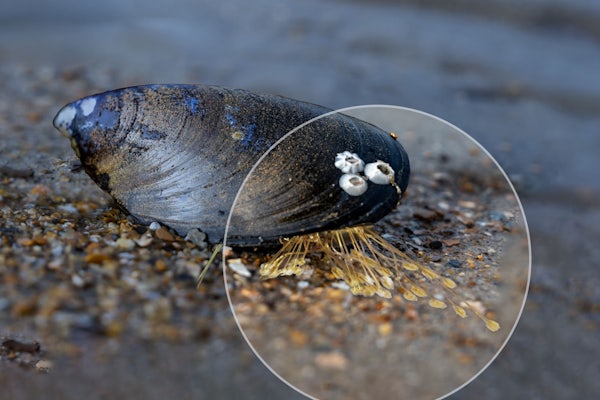Drawing Inspiration from the Muscle of the Mussel Foot
Scientists aim to mimic a mussel’s ability to stick to surfaces to bioengineer novel materials

In the vastness of the world’s oceans, the mussel—a mere two to six inches in stature—is proving that strength comes in all sizes.
Specifically, this brawn comes from an even more unlikely part of the mussel—its “foot,” which is the largest organ of these bivalve creatures. The mussel uses its foot, or byssus, to move, to defend itself, and to burrow through sand, silt, and gravel. The muscular foot secretes proteins with powerful adhesive-like fibers, known as the “beard,” which stick to rocks, piers, and even other mussels, making it a longstanding, enviable creator of natural adhesive.
For more than half a century, scientists have been studying mussel foot proteins and how to synthetically duplicate their natural strength. In more recent years, researchers have begun exploring the creation of synthetic versions of mussel foot proteins with potential industrial and medical applications. Research using synthetic biology has demonstrated that recombinant proteins, composed of hybrid mussel foot and spider silk peptide segments, could be used as a biodesign for novel hydrogels with applications as underwater adhesives.
A team, led by Marcus Foston of Washington University in St. Louis, is using advanced capabilities at the Environmental Molecular Sciences Laboratory (EMSL), a Department of Energy user facility, to study material generated using biology, specifically examining how a protein’s amino acid sequence can affect hydrogel composition, structure, and performance. The long-term goal of this project: to develop hydrogels that could seal the cracks in boats or as a surgical adhesive.
Foston’s project is one of 20 that were awarded funding through an EMSL Exploratory Research call, which enables access to the EMSL user facility’s scientific instrumentation and expertise to advance research in environmental and biological science. Listen to Foston explain his research to develop this hydrogel on the Bonding Over Science podcast episode, "The Muscle of Mussel."
Read the full story here.




